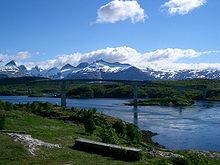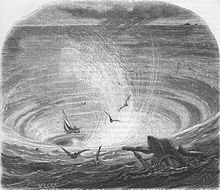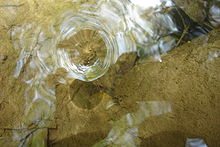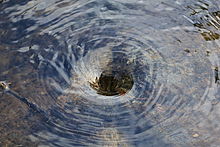Whirlpool
This is Wikipedia's current article for improvement – and you can help edit it! You can discuss how to improve it on its talk page and ask questions at the help desk or Teahouse. See the cheatsheet, tutorial, editing help and FAQ for additional information. Editors are encouraged to create a Wikipedia account and place this article on their watchlist.
Find sources: "Whirlpool" – news · newspapers · books · scholar · JSTOR |

A whirlpool, is a body of swirling water produced by the meeting of opposing currents. The vast majority of whirlpools are not very powerful and very small whirlpools can easily be seen when a bath or a sink is draining. More powerful ones in seas or oceans may be termed maelstroms. Vortex is the proper term for any whirlpool that has a downdraft.
In oceans, in narrow straits, with fast flowing water, whirlpools are normally caused by tides; there are few stories of large ships ever being sucked into such a maelstrom, although smaller craft are in danger.[1][2] Smaller whirlpools also appear at the base of many waterfalls.[3] In the case of powerful waterfalls, like Niagara Falls, these whirlpools can be quite strong.
Basically, it is generated due to the "convergence opposing forces". According to James Kenny the definition is: "The maelstrom arises as a result of a dramatic discontinuity in the ocean floor that disturbs the tidal flow, allowing a rising tide to begin its inflow well before the preceding tide has ebbed. The consequence, of course, is a confusion of flows, generating a rotary".[4]
Notable whirlpools

Moskstraumen
Moskstraumen is an unusal system of whirlpools in the open seas in the Lofoten Islands off the Norwegian coast.[5] It is the second strongest whirlpool in the world with flow currents reaching speeds as high as 32 km/h (20 mph). It finds mention in several books and movies.[6]
The Moskstraumen is formed by the combination of powerful semi-diurnal tides and the unusual shape of the seabed, with a shallow ridge between the Moskenesøya and Værøy islands which amplifies and whirls the tidal currents.[7]
The fictional depictions of the Maelstrom by Edgar Allan Poe and Jules Verne describe it as a gigantic circular vortex that reaches the bottom of the ocean, when in fact it is a set of currents and crosscurrents with a rate of 18 km/h (11 mph).[8] Poe described this phenomenon in his short story A Descent into the Maelstrom, which in 1841 was the first to usage of the word "maelstrom" in the English language;[7] in this story related to the Lofoten Maelstrom, two fishermen are swallowed by the maelstrom while one survives miraculously.[4]
Saltstraumen

The maelstrom of Saltstraumen is the world's strongest maelstrom, close to the Arctic Circle[6] and is located 33 km (20 mi) round the bay on the Highway 17, south-east of the city of Bodø, Norway. The strait at its narrowest is 150 m (490 ft) in width and water "funnels" through the channel four times a day.[9] It is estimated that 400 million cubic meter of water passes the narrow strait during this event.[10] The water is creamy in colour and most turbulent during high tide, which is witnessed by thousands of tourists.[9] It reaches speeds of 40 km/h (25 mph).;[7] with mean speed of about 13 km/h (8.1 mph). As navigation is dangerous in this strait only a small slot of time is available for large ships to pass through.[6] Its impressive strength is caused by the world's strongest tide occurring in the same location during the new- and full moon. A narrow channel of 3 km (2 mi) length connects the outer Saltfjord with its extension, the large Skjerstadfjord, causing a colossal tide which in turn produces the Saltstraumen maelstrom.[11]
Corryvreckan

The Corryvreckan is a narrow strait between the islands of Jura and Scarba, in Argyll and Bute, on the northern side of the Gulf of Corryvreckan, Scotland. It is the third-largest whirlpool in the world.[6] Flood tides and inflow from the Firth of Lorne to the west can drive the waters of Corryvreckan to waves of over 9 metres (30 ft), and the roar of the resulting maelstrom, which reaches speeds of 18 km/h (11 mph), can be heard 16 kilometres (9.9 mi) away. Though it was initially classified as non-navigable by the British navy it was later categorized as "extremely dangerous".[6]
A documentary team from Scottish independent producers Northlight Productions once threw a mannequin into the Corryvreckan ("the Hag") with a life jacket and depth gauge. The mannequin was swallowed and spat up far down current with a depth gauge reading of 262 metres (860 ft) with evidence of being dragged along the bottom for a great distance.[12]
Other notable maelstroms and whirlpools

Old Sow whirlpool is located between Deer Island, New Brunswick, Canada, and Moose Island, Eastport, Maine, USA. It is given the epithet "pig-like" as it makes a screeching noise when the vortex is at its full fury. The smaller whirlpools around this Old Sow are known as "Piglets.[6] and reaches speeds of up to 27.6 km/h (17.1 mph).[7]
The Naruto whirlpools are located in the Naruto Strait near Awaji Island in Japan, which have speeds of 26 km/h (16 mph).[7]
Skookumchuck Narrows is a tidal rapids that develops whirlpools, on the Sunshine Coast, Canada with current speeds exceeding 30 km/h (19 mph).[7]
French Pass (Te Aumiti) is a narrow and treacherous stretch of water that separates D'Urville Island from the north end of the South Island of New Zealand. In 2000 a whirlpool there caught student divers, resulting in multiple fatalities.[13]
There was a short-lived whirlpool that sucked in a portion of the Lake Peigneur of 1300 acre area in Louisiana, United States after a drilling mishap in November 1980. This was not a naturally-occurring whirlpool, but a man-made disaster caused by breaking through the roof of a salt mine. This mishap resulted in destruction of five houses, loss of nineteen barges and eight tug boats, oil rigs, a mobile home and most of the botanical garden and 10 percent area of the nearby Jefferson Island. A crater of 0.5-mile was created. The lake then drained, until the mine filled and the water levels equalized but the three-foot deep lake was now 1,300 feet deep. Nine of the barges which had sunk floated back.[14][15][16]
A more recent example of a man-made whirlpool that received significant media coverage was in early June 2015, when an intake vortex formed in Lake Texoma, on the Oklahoma–Texas border, near the floodgates of the dam that forms the lake. At the time of the whirlpool's formation, the lake was being drained after reaching its highest level ever. The Army Corps of Engineers, which operates the dam and lake, expected that the whirlpool would last until the lake reached normal seasonal levels by late July.[17]
Dangers

Powerful whirlpools have killed unlucky seafarers, but their power tends to be exaggerated by laymen.[18] There are virtually no stories of large ships ever being sucked into a whirlpool. Tales like those by Paul the Deacon, Edgar Allan Poe, and Jules Verne are entirely fictional.[19]
In literature and popular culture
Apart from Poe and Verne other literary source is of the 1500s, of Olaus Magnus, a Swedish Bishop, who had stated that the maelstrom which was more powerful than The Odyssey destroyed ships which sank to the bottom of the sea, and even whales were sucked in. Pytheas, the Greek historian, also mentioned that maelstroms swallowed ships and threw them up again.[1]
Charybdis in Greek mythology was later rationalized as a whirlpool, which sucked entire ships into its fold in the narrow coast of Sicily, a disaster faced by navigators.[20]
In the 8th century, Paul the Deacon, who had lived among the Belgii, described tidal bores and the maelstrom for a Mediterranean audience unused to such violent tidal surges:[21]
Not very far from this shore … toward the western side, on which the ocean main lies open without end, is that very deep whirlpool of waters which we call by its familiar name "the navel of the sea." This is said to suck in the waves and spew them forth again twice every day. … They say there is another whirlpool of this kind between the island of Britain and the province of Galicia, and with this fact the coasts of the Seine region and of Aquitaine agree, for they are filled twice a day with such sudden inundations that any one who may by chance be found only a little inward from the shore can hardly get away. I have heard a certain high nobleman of the Gauls relating that a number of ships, shattered at first by a tempest, were afterwards devoured by this same Charybdis. And when one only out of all the men who had been in these ships, still breathing, swam over the waves, while the rest were dying, he came, swept by the force of the receding waters, up to the edge of that most frightful abyss. And when now he beheld yawning before him the deep chaos whose end he could not see, and half dead from very fear, expected to be hurled into it, suddenly in a way that he could not have hoped he was cast upon a certain rock and sat him down.
— Paul the Deacon, History of the Lombards, i.6
Three of the most notable literary references to the Lofoten Maelstrom date from the nineteenth century. The first is the Edgar Allan Poe short story "A Descent into the Maelström" (1841). The second is 20,000 Leagues Under the Sea (1870), the famous novel by Jules Verne. At the end of this novel, Captain Nemo seems to commit suicide, sending his Nautilus submarine into the Maelstrom (although in Verne's sequel Nemo and Nautilus survived). The "Norway maelstrom" is also mentioned in Herman Melville's Moby-Dick.[22]
In the 'Life of St Columba', the author, Adomnan of Iona', attributes to the saint miraculous knowledge of a particular bishop who ran into a whirlpool off the coast of Ireland. In Adomnan's narrative, he quotes Columba saying[23]
Cólman mac Beognai has set sail to come here, and is now in great danger in the surging tides of the whirlpool of Corryvreckan. Sitting in the prow, he lifts up his hands to heaven and blesses the turbulent, terrible seas. Yet the Lord terrifies him in this way, not so that the ship in which he sits should be overwhelmed and wrecked by the waves, but rather to rouse him to pray more fervently that he may sail through the peril and reach us here.
Etymology
One of the earliest uses in English of the Scandinavian word (malström or malstrøm) was by Edgar Allan Poe in his short story "A Descent into the Maelström" (1841). In turn, the Nordic word is derived from the Dutch maelstrom, modern spelling maalstroom, from malen (to grind) and stroom (stream), to form the meaning grinding current or literally "mill-stream", in the sense of milling (grinding) grain.[24]
- Whirlpools
-
A whirlpool in a glass of water
-
A small whirlpool in Tionesta Creek in the Allegheny National Forest
-
A whirlpool in a small pond
-
Tide whirlpool in Rooi-Els, Western Cape
-
A man-made whirlpool in the Water Garden within Alnwick Garden
See also
References
- ^ a b Cussler, Clive; Kemprecos, Paul (7 June 2012). Polar Shift: NUMA Files #6. Penguin Books Limited. p. 94. ISBN 978-1-4059-0959-4.
- ^ 10 Magnificent Maelstroms. WebEcoist. Retrieved 26 October 2011.
- ^ Carreck, Rosalind, ed. (1982). The Family Encyclopedia of Natural History. The Hamlyn Publishing Group. p. 246. ISBN 0-7112-0225-7.
- ^ a b James Kenney (19 December 2012). Thriving in the Crosscurrent: Clarity and Hope in a Time of Cultural Sea Change. Quest Books. pp. 143–. ISBN 978-0-8356-3019-1.
- ^ Encyclopædia Britannica, 1958 edition.
- ^ a b c d e f Doyle, James (1 March 2012). A Young Scientist's Guide to Defying Disasters. Gibbs Smith. p. 15. ISBN 978-1-4236-2441-7.
- ^ a b c d e f Compton, Nic (28 July 2013). Why Sailors Can't Swim and Other Marvellous Maritime Curiosities. Bloomsbury Publishing. pp. 78–79. ISBN 978-1-4081-9263-4.
- ^ B. Gjevik, H. Moe and A Ommundseb, "Strong Topographic Enhancement of Tidal Currents: Tales of the Maelstrom", University of Oslo, working paper, 5 September 1997. A condensed version published as Gjevik, B.; Moe, H.; Ommundsen, A. (1997). "Sources of the Maelstrom" (PDF). Nature. 388 (6645): 837–838. doi:10.1038/42159. Archived from the original (PDF) on 24 April 2004.
- ^ a b Brown, Jules (2004). The Rough Guide to Barcelona. Rough Guides. p. 355. ISBN 978-1-84353-218-7. Retrieved 25 May 2016.
- ^ Michelin Travel Publications (Firm) (2001). Scandinavia – Finland. Michelin Travel Publications. p. 201. ISBN 978-2-06-000140-1. Retrieved 25 May 2016.
- ^ "Saltstraumen" (in Norwegian). Store Norske Leksikon. Retrieved 23 May 2016.
- ^ "Equinox: Lethal Seas". UK and US co-production by Northlight, "Lethal Seas" UK Channel 4, "Sea Twister!" US Discovery Channel, covers several notable maelstroms.
- ^ Smith, I R (14 April 2003). "In the matter of an inquest into the deaths of Narelle Taniko te Purei, Ricki Graeme McDonald and Michael David Welsh" (PDF). Nelson District Coroner – via Dive New Zealand.
- ^ Stephen Pile (4 October 2012). The Not Terribly Good Book of Heroic Failures: An intrepid selection from the original volumes. Faber & Faber. pp. 146–. ISBN 978-0-571-27734-6.
- ^ Richard Heggen (16 January 2015). Underground Rivers: From the River Styx to the Rio San Buenaventura, with occasional diversions. Richard Heggen. pp. 1108–. GGKEY:BS7JB1BB957.
- ^ "And away goes the lake down the drain!". Archive of tripod.com. Retrieved 23 May 2016.
- ^ Smith, Chelsi (8 June 2015). "Levels at Lake Texoma decrease; rare look at intake vortex". Sherman, TX: KXII-TV. Retrieved 30 June 2015.
- ^ MythBusters Episode 56: Killer Whirlpool. Mythbustersresults.com. Retrieved 26 October 2011.
- ^ Paul the Deacon, History of the Lombards (8th century AD); Edgar Allan Poe, "A Descent into the Maelström" (1841); and Jules Verne, Twenty Thousand Leagues Under the Sea (1870).
- ^ Andrews, Tamra (2000). Dictionary of Nature Myths: Legends of the Earth, Sea, and Sky. Oxford University Press. p. 171. ISBN 978-0-19-513677-7. Retrieved 25 May 2016.
- ^ Deacon, Paul the (3 June 2011). History of the Lombards. University of Pennsylvania Press. p. 8. ISBN 0-8122-0558-8.
- ^ Herman Melville Moby-Dick Chapter 36, Wikisource.
- ^ Adomnan of Iona. Life of St Columba. Penguin Books, 1995
- ^ The Merriam-Webster new book of word histories. Merriam-Webster, Inc. 1991. p. 300. ISBN 978-0-87779-603-9. Retrieved 25 May 2016.
Further reading
- Baron PA, Willeke K (1986) Respirable droplets from whirlpools: measurements of size distribution and estimation of disease potential. Environ Res 39, 8–18.
- Blake, John Lauris (1845). The Wonders of the Ocean. Henry & Sweetlands. pp. 50–53.








